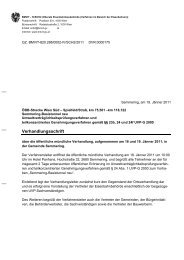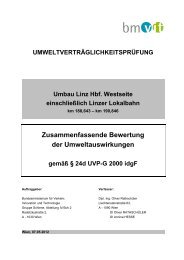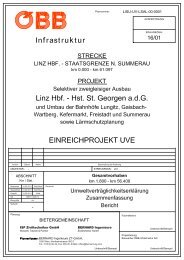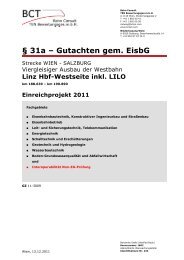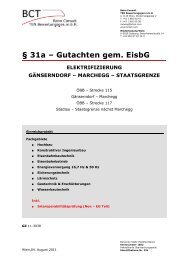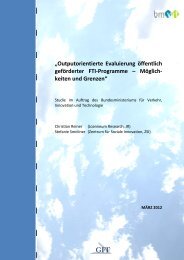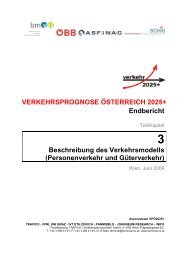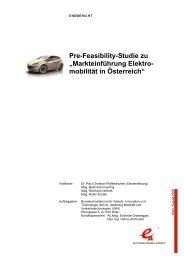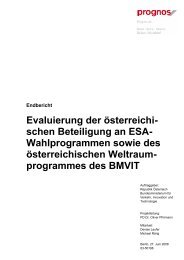Schriftenreihe .;technologiekompetenz Verkehr in
Schriftenreihe .;technologiekompetenz Verkehr in
Schriftenreihe .;technologiekompetenz Verkehr in
Create successful ePaper yourself
Turn your PDF publications into a flip-book with our unique Google optimized e-Paper software.
ELECTRIC MACHINES<br />
The speed and torque of electric mach<strong>in</strong>es can be regulated<br />
very flexibly. Independent of the mach<strong>in</strong>e type, the speed and<br />
torque of the mach<strong>in</strong>e can be adjusted to the requirements of<br />
the drive us<strong>in</strong>g modern power electronics. Mechanical<br />
transmissions or clutches are not essential. Depend<strong>in</strong>g on the<br />
power requirement and the available space, brush DC motors or<br />
<strong>in</strong>duction motors can be used. The electrical drives for comfort<br />
systems are ma<strong>in</strong>ly realised us<strong>in</strong>g brush DC drives, whereas<br />
<strong>in</strong>duction motors can also be used for electric auxiliary units,<br />
depend<strong>in</strong>g on the power requirement. However, with regard to<br />
electric auxiliary units, special emphasis on the development of<br />
compact, highly <strong>in</strong>tegrated and low-cost components is needed.<br />
The ma<strong>in</strong> advantages of electric drives for traction, compared to<br />
conventional propulsion systems, are their higher efficiency,<br />
robustness and better controllability. The efficiency of electrical<br />
traction is about 90%, depend<strong>in</strong>g on the performance class.<br />
Advantage<br />
Drawback<br />
AIM<br />
+ Simple and robust assembly<br />
+ Mach<strong>in</strong>e is passive, with no voltage or torque under<br />
currentless conditions<br />
+ Good short-term overload behaviour<br />
+ No danger of demagnetisation dur<strong>in</strong>g overload operation<br />
+ Easy implementation of field weaken<strong>in</strong>g to expand the<br />
speed range<br />
+ Slightly lower costs<br />
- Lower power density<br />
- Higher weight<br />
- Additional current required to magnetise the rotor<br />
- lower power factor due to magnetization current<br />
ELECTRIC DRIVES<br />
The efficiency of propulsion systems us<strong>in</strong>g ICE is about 30%,<br />
due to thermodynamic restrictions. A further advantage is that<br />
electric drive systems require far less ma<strong>in</strong>tenance.<br />
Due to their robust assembly, their power density and their high<br />
dynamics, three-phase <strong>in</strong>duction motors are preferable to direct<br />
current mach<strong>in</strong>es. Permanent magnet synchronous motors<br />
(PMSM) offer particular advantages due to their high power<br />
density. However, the choice between an asynchronous<br />
<strong>in</strong>duction motor (AIM) or a PMSM depends largely on the<br />
requirements and the design of the vehicle. The selection<br />
process to identify the most appropriate mach<strong>in</strong>e type needs to<br />
be based on a comprehensive vehicle simulation which takes<br />
<strong>in</strong>to account the given vehicle application (def<strong>in</strong>ed by the driv<strong>in</strong>g<br />
cycle, range, acceleration, etc.), as well as the entire powertra<strong>in</strong><br />
concept and the <strong>in</strong>terdependencies with other vehicle<br />
components, such as the battery system or the combustion<br />
eng<strong>in</strong>e.<br />
PMSM<br />
+ High power density<br />
+ Lower weight<br />
+ Short-term overload capacity<br />
+ No power loss to excitation field production<br />
+ better power factor below field-weaken<strong>in</strong>g<br />
- Complex rotor assembly through use of various materials<br />
such as metals, magnets, adhesives<br />
- Temperature sensitivity of the rotor<br />
- In case of rotat<strong>in</strong>g the mach<strong>in</strong>e mechanically the<br />
permanent magnets cause <strong>in</strong>duced voltages even if the<br />
mach<strong>in</strong>e is not connected electrically<br />
- Active field weaken<strong>in</strong>g due to additional current required<br />
to expand the speed range<br />
- Slightly higher costs<br />
Table 1: Comparison between the ma<strong>in</strong> advantages and drawbacks of asynchronous <strong>in</strong>duction mach<strong>in</strong>es (AIM) and permanent magnet synchronous mach<strong>in</strong>es (PMSM)<br />
Cross section of an AIM Cross section of a PMSM<br />
31





